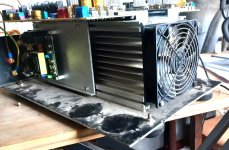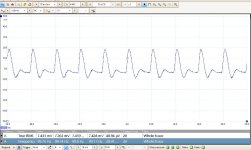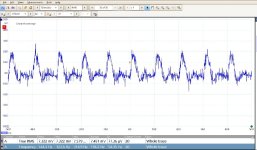I think these have been mentioned on here before: (Connexelectronic)
https://hifimediy.com/product/smps300re-36v-dual-voltage-110v-power-supply/
I bought a pair of +-36v 300w models to replace the linear psu in my Krell KSA50 clones. (derated to about 30w to drive the mid woofers) so I am hoping this isn't a mistake!
https://hifimediy.com/product/smps300re-36v-dual-voltage-110v-power-supply/
I bought a pair of +-36v 300w models to replace the linear psu in my Krell KSA50 clones. (derated to about 30w to drive the mid woofers) so I am hoping this isn't a mistake!
Audio grade? Sales talk, nothing more.
A switch mode power supply is what it says on the label. Pity there is no stated Power Factor error. That is what makes them efficient.
Should be fine for supplying an amplifier if there is no HF ripple. If there is, you may need noise suppression on the rails and a good earth connection.
What is wrong with the power supply designed to work with your amplifier, I have to ask.
A switch mode power supply is what it says on the label. Pity there is no stated Power Factor error. That is what makes them efficient.
Should be fine for supplying an amplifier if there is no HF ripple. If there is, you may need noise suppression on the rails and a good earth connection.
What is wrong with the power supply designed to work with your amplifier, I have to ask.
Yes I am wary of the sales hype and am probably going to fit a CMC between it and the amp pcbs.
I decided to go against my aversion to smps in audio gear because of the smaller size and weight.
The original psu was a 500va 25-0-25 toroid and 0.1F capacitors in a separate enclosure so the total weight, even if in one housing would have been too heavy for me.
Assuming satisfactory performance from 100-10k I can rebuild it into a single 5u case.
I may/probably will need to screen them even though they are at the opposite end of the pcbs to the inputs.

I decided to go against my aversion to smps in audio gear because of the smaller size and weight.
The original psu was a 500va 25-0-25 toroid and 0.1F capacitors in a separate enclosure so the total weight, even if in one housing would have been too heavy for me.
Assuming satisfactory performance from 100-10k I can rebuild it into a single 5u case.
I may/probably will need to screen them even though they are at the opposite end of the pcbs to the inputs.

yup, sound like snake oil...Audio grade? Sales talk, nothing more.
A switch mode power supply is what it says on the label. Pity there is no stated Power Factor error. That is what makes them efficient.
Should be fine for supplying an amplifier if there is no HF ripple. If there is, you may need noise suppression on the rails and a good earth connection.
What is wrong with the power supply designed to work with your amplifier, I have to ask.
How is this snake oil? It's a power supply. OK it's promoted as 'audio grade', what does that mean? To me audio grade is not a high bar. If you read thru the description, it's meant to class D amps that require split supplies. Whether you have a linear or smps, the output rails have ripple. Linear supplies produce 120Hz. I would argue that ripple on an smps is well beyond the audible range since many are f=100-200kHz. But this one says:
Ripple (noise): 31mV @ 1A, 86mV @ 8A
If this is a supply for a power amp, there isn't much gain - maybe 20 or 30 -- if it couples into the input stage. And if the amplifier's PSRR is any good, the ripple will be rejected. Maybe the high sw freq has components in the audible range but I think you should try it out. Hopefully it's a constant freq switcher, probably is. I would encourage batteryman to try it - and report back . You don't want to use the large reservoir caps, smps typ have a startup problems if the output caps are too big or they dont limit the current at startup if the ramp is fast. I've been thinking about smps for my own projects.
. You don't want to use the large reservoir caps, smps typ have a startup problems if the output caps are too big or they dont limit the current at startup if the ramp is fast. I've been thinking about smps for my own projects.
Edit: one of comments on hifimediy were that it produced a lot of noise, I'm guessing radiated noise. If you have high impedance nodes (input is one), then you'll need to add filtering/ferrite beads. Or put it in a faraday cage. LOL.
Ripple (noise): 31mV @ 1A, 86mV @ 8A
If this is a supply for a power amp, there isn't much gain - maybe 20 or 30 -- if it couples into the input stage. And if the amplifier's PSRR is any good, the ripple will be rejected. Maybe the high sw freq has components in the audible range but I think you should try it out. Hopefully it's a constant freq switcher, probably is. I would encourage batteryman to try it - and report back
Edit: one of comments on hifimediy were that it produced a lot of noise, I'm guessing radiated noise. If you have high impedance nodes (input is one), then you'll need to add filtering/ferrite beads. Or put it in a faraday cage. LOL.
Last edited:
I have so far installed one for the right channel into my Krell KSA50 clone and am very happy with the results.
The auxilliary + - 12v output supplies the speaker protector and 4" 3 speed fan.
At +- 36v @ 2amps per rail, the SMPS mosfets are slighly warm - 50C
I'll post REW screenshots later but the noise spectrum of the amp does not show anything unwaanted.
The auxilliary + - 12v output supplies the speaker protector and 4" 3 speed fan.
At +- 36v @ 2amps per rail, the SMPS mosfets are slighly warm - 50C
I'll post REW screenshots later but the noise spectrum of the amp does not show anything unwaanted.
These SMPS have been build for and used with amps of any class. Used right they are 100% capable to do the job. An additional C-L-C filtering will always give improvement on the osciloscope. If thhis results in audible or measureable improvement at the output of the amp, is questionable.
Indeed you can not fit that much capacity between an SMPS as you would with a transformer/ rectifier based 50Hz PS. Use less, but very close to the amps power transistors instead.
Options about conventionel / SMPS are very subjective and differ. Many report better sound with an SMPS, some prefer the old style. As always in audio, a matter of religion. If you want to know for sure, build two identical amps, one with conventionel and one with SMPS. Tweak both to best sound and do a blind A/B test. Anything else is just opinion, not factual. If your amps are Mono, you may do a mono A/B test. You should be able to hear any significant difference. Or not...
Indeed you can not fit that much capacity between an SMPS as you would with a transformer/ rectifier based 50Hz PS. Use less, but very close to the amps power transistors instead.
Options about conventionel / SMPS are very subjective and differ. Many report better sound with an SMPS, some prefer the old style. As always in audio, a matter of religion. If you want to know for sure, build two identical amps, one with conventionel and one with SMPS. Tweak both to best sound and do a blind A/B test. Anything else is just opinion, not factual. If your amps are Mono, you may do a mono A/B test. You should be able to hear any significant difference. Or not...
Maybe the technology has improved to the point where they are fine for Audio?
I already us a CMC to filter a 19v Laptop psu for the heaters of my DAC buffers and of course all my commecrial devices have wallwart smps'.
I was concerned that mounting them so close to the amp pcb's might allow radiated noise to be a problem but it doesn't seem to be.
I already us a CMC to filter a 19v Laptop psu for the heaters of my DAC buffers and of course all my commecrial devices have wallwart smps'.
I was concerned that mounting them so close to the amp pcb's might allow radiated noise to be a problem but it doesn't seem to be.
I am all against snake oil salesman talk but ln this particular issue they may have a point.
Average cheap SMPS around has horrible noisy spikey output, very contaminated rails, because they are meant for crude duty such as powering LED strips and such, so a model who took care to provide clean voltage qualifies as "Audio Grade" to me.
Yes, they could have labelled it "suitable to power Class AB audio amplifiers" or something, but won't get angry st them for that.
Average cheap SMPS around has horrible noisy spikey output, very contaminated rails, because they are meant for crude duty such as powering LED strips and such, so a model who took care to provide clean voltage qualifies as "Audio Grade" to me.
Yes, they could have labelled it "suitable to power Class AB audio amplifiers" or something, but won't get angry st them for that.
Why? I can't take any (high-end) component with a SMPS inside serious, no mather how good they measure.
Cheap garbage, marketed by companies to sell cheap stuf for max profit. Al you will do to keep the noise down are band aids who create problems at their own. Any LPS wil be better for audio.
A SMPS in a Krell
Cheap garbage, marketed by companies to sell cheap stuf for max profit. Al you will do to keep the noise down are band aids who create problems at their own. Any LPS wil be better for audio.
A SMPS in a Krell

Have a look at a conventional power supply on the osciloscope. There is not only the ripple from the loading current, but also all kind of other dirt, if you look close. The capacitor bank, even if you use something like 100.000uF doesn't absorb this. C-L-R does better, but even some dirt remains. That is why you use some smaller caps in the low mF range, too.
- Home
- Amplifiers
- Power Supplies
- Audio Grade SMPS

